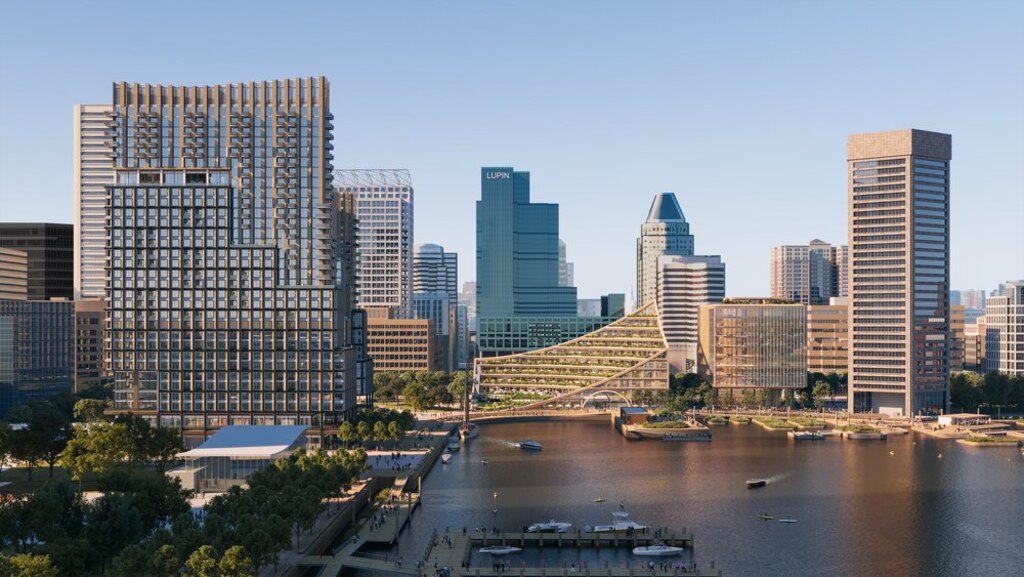When a developer unveiled designs last month for a reimagining of Baltimore’s Inner Harbor, politicians gushed. Then the architects took a look.
To Pavlina Ilieva, the chair of Baltimore’s Urban Design and Architecture Advisory Panel, or UDAAP, it seemed like someone had asked ChatGPT to create a masterplan of a waterfront development.
“I consider these all marketing images,” said Ilieva at a meeting Thursday morning.
It was the first of many public hearings for MCB Real Estate and its managing partner, P. David Bramble, who is pitching an ambitious redevelopment of Harborplace. Bramble wants to tear down the twin pavilions, reconfigure the nearby streets, add green space and erect five buildings — including two residential towers. The estimated price tag is nearly $1 billion.
The Baltimore Banner thanks its sponsors. Become one.
Bramble said he was “extremely excited” to present the designs to UDAAP, and Ilieva and other members of Baltimore’s architectural review panel commended Bramble and MCB’s architects for their effort and ambition. Then came the criticism.
There was no cohesive vision, no supporting research, little explanation of design choices and an oversimplified view of a very complex space, they said. Perhaps most importantly, Ilieva said, was that the plan lacked a fundamental analysis of what made Harborplace a success initially — and a failure today.

Harborplace was a sensation when it opened four decades ago, attracting millions of visitors to downtown Baltimore and its waterfront, but today much of Harborplace is unused and falling into disrepair. The pavilions, which feature a mix of retail shops and restaurants, are located on city-owned land along the Inner Harbor, but the buildings are privately owned and managed.
MCB bought Harborplace out of receivership after its previous owner defaulted on its debt. After hosting meetings with community members and stakeholders, MCB unveiled its plans for Harborplace and the surrounding public space on Oct. 30.
Their plans call for a significant reduction in car lanes along Pratt and Light Streets, including the elimination of a spur that separates McKeldin Plaza from the Inner Harbor promenade. More lanes for pedestrians, cyclists and mass transit would be added. The promenade would be rebuilt. A park, a pond, and lots of trees would be added. Renderings showed people swimming and kayaking among floating docks in the harbor.
The Baltimore Banner thanks its sponsors. Become one.
The pavilions would be razed and five new buildings would be constructed, including “the sail,” a commercial building with a curved roof designed by an architectural firm in Copenhagen.
According to Alexandra Hughes, spokesperson for MCB, the current redevelopment plans call for $500 million of private investment and $400 million of public money. That includes about $200 million for promenade improvements, $75 million to $100 million to reconstruct the nearby streetscape, and $100 million for the park space.
While members of UDAAP offered plenty of criticism Thursday morning, the panel is an advisory group. It does not approve or deny projects, but major development proposals must go before UDAAP for multiple hearings before the Department of Planning issues permits for a project. The panel encouraged MCB to take a step back and reconsider basic aspects of the project, including whether all five buildings are necessary.
Ilieva said she felt perplexed, alarmed and surprised when reviewing the proposal, which had hand-drawn sketches followed by fully rendered scenes, with no explanation of the design process.
Another member of UDAAP, Osborne Anthony, said he wanted a design that would honor Baltimore’s grittiness.
The Baltimore Banner thanks its sponsors. Become one.
“What I see here is a very slick and chic presentation, but slick and chic isn’t always the answer,” Anthony said.
In a statement after the hearing, Bramble called it a positive experience.
“We were pleased that UDAAP began the meeting by acknowledging the bold vision for the reimagination of Harborplace that has been informed by months of community meetings,” Bramble said. “The time that UDAAP took to provide constructive criticism on the initial designs will help move the process forward.”
Bramble will have many more opportunities to discuss and present MCB’s vision for the Inner Harbor.
In addition to more hearings before UDAAP, the redevelopment of Harborplace will also need amendments to its zoning, to the city charter and to the Inner Harbor’s urban renewal plan, all of which will go before the City Council, city planning staff said. Several government agencies — city, state and federal — will need to review aspects of the plan. Voters will also have to approve any amendments to the city charter.
The Baltimore Banner thanks its sponsors. Become one.
Then demolition and construction can start.




Comments
Welcome to The Banner's subscriber-only commenting community. Please review our community guidelines.